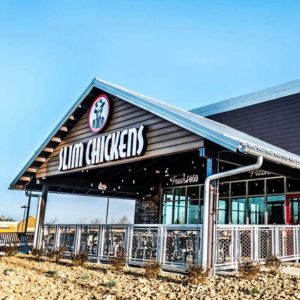The pandemic inspired fast casuals to adopt drive-thrus and delivery, marking the beginning of a new innovation era that has led to new restaurant designs and technological solutions to supply chain and labor shortage challenges.
 When COVID-19 hit, fast-casual restaurants transformed their parking lots into dining rooms in the form of curbside service, and concepts that once prided themselves on not offering big chain-associated drive-thrus promptly began adopting the format to serve customers. Then, the industry saw restaurant groups start partnering with third-party delivery providers, despite many claiming they would never do so because of the steep fees.
When COVID-19 hit, fast-casual restaurants transformed their parking lots into dining rooms in the form of curbside service, and concepts that once prided themselves on not offering big chain-associated drive-thrus promptly began adopting the format to serve customers. Then, the industry saw restaurant groups start partnering with third-party delivery providers, despite many claiming they would never do so because of the steep fees.
“I thought that honestly once COVID was dwindling down, that part of the business would subside a little bit and people would go back to their normal routines. Well what we’ve seen is, delivery is now a part of the normal routine, and that part of the business has not dropped off,” says Sam Rothschild, chief operating officer of 200-unit Slim Chickens.
Indeed, consumers are now conditioned to expect food delivered to their front doors at the tap of a touchscreen, and study after study keeps proving the steep fees are no match for the value of convenience. Delivery orders now account for about 10 percent of Slim Chickens’ business, while curbside, takeout, and catering make up about 20 percent. Drive-thru business is 50 percent, and the other 20 percent is dine-in— whereas pre-pandemic, dine-in accounted for about 35 percent of sales.
“We had to come up with new standard operating procedures, because you grew entirely overnight a whole new day part or segment of your business that really wasn’t there before, because delivery in our segment was very small, and takeout was OK,” Rothschild says.
That meant reevaluating packaging, staffing, design layouts, and more. If “pivot,” “unprecedented,” and “new normal” were the buzzwords of 2021, “optimization,” “efficiency,” and “new prototype” are gaining cause to be called the popular clichés of 2022—for good reason.
Now that dining rooms are filling up again, yet off-premises channels remain far elevated to prior levels, restaurateurs are grappling with how to balance their various business formats in a way that satisfies consumers and their labor force—groups with higher expectations and standards than ever, which isn’t necessarily a bad thing. Pandemic-related pressures continue to force the restaurant industry to make progress with new, creative solutions to improve customer and employee experiences, which in turn make for better systems overall.
Slim Chickens, for example, reconfigured its restaurants’ kitchens and designated parking spaces for delivery drivers to help optimize the flow for employees and guests. After recently bringing on a new vice president of technology, the brand is also looking at implementing new technologies in the drive-thru and adding staff members armed with order entry pads in parking lots to increase throughput.
“We spent a lot of time over the last year retooling our prototype, then going back and starting to do some work in the kitchens we already have, looking at new equipment and new processes,” Rothschild says, which also included reengineering cook lines, and moving around existing equipment to increase food quality, accuracy, and speed. “We’re just trying to get more efficient and keep costs under control with lots of out of the box thinking.”
Flexibility in Design has become a staple of fast- casual coming out of COVID-19
Finding solutions to supply chain challenges
Despite progress being made in so many areas, the restaurant industry still faces strong headwinds, from supply chain and labor to inflationary pressures. The National Restaurant Association published a survey in November 2021 that found 95 percent of restaurants experienced significant supply delays or shortages of key food items, and 75 percent of restaurants have made menu changes because of those issues.
At Slim Chickens, having a menu centered around one protein helped, Rothschild says, plus boasting an experienced supply chain team who developed great relationships with vendors.
“We were chasing some supply stuff around, but we never had a real issue where we couldn’t serve our menu,” Rothschild says. “Where we ran into issues like my peers was the cups, the lids, the straws, and plastic ancillary items in supply chain, which was one of the most challenging we saw.
”Issues with plastic ancillary items had more to do with manufacturers being understaffed and not being able to keep up with orders, he notes. While restaurants experienced issues with stocking enough of their inventory earlier on in the pandemic, it’s now transitioned to feeling the effects from staffing challenges hitting broadliner and supplier partners.
“There’s a greater incident potential for new people at a broadliner pulling product or mispicking, so we could get romaine instead of spring mix,” Robison says. “We’re going to have to continue to work on this industry side by side with our broadliners to understand what they’re facing, yet also hold them accountable for what we need from them to take care of our guests.”
Bolstering employee benefits is no longer a trend, but a thoughtful necessity
According to the National Restaurant Association, no other industry has faced a longer road to reaching a full employment recovery. As of April 2022, eating and drinking places were still down 794,000 jobs, or 6.4 percent below pre-pandemic employment levels.
Rothschild thinks the restaurant industry has a retention issue, not necessarily a hiring issue. For him, the key to increasing retention rates in restaurants is hiring exceptional general managers as leaders, who inspire employees in a fun environment.
“They want to work in a really nice place where they’re appreciated for the work they do and have great team members to work with. When I see great GMs who know how to take care of their team and run a restaurant, they don’t have problems hiring or retaining people, because good people want to work for good people,” Rothschild says.
“Make sure you have great leaders and people running your restaurants, and staffing should help itself,” Rothschild adds, though he admits there are areas of the country within smaller population pockets where companies need to be creative about recruiting and sometimes offer unusual incentives. “One prong is attracting people to get them to apply, and the other is taking really good care of them when they do decide to work for you.
To read the full story from QSR click here: https://bit.ly/3x1Nhmo

